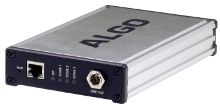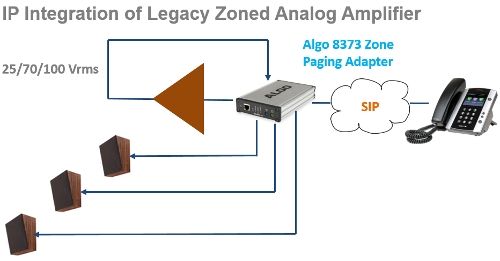
Description
Algo 8373 IP Zone Paging Adapter
Algo 8373 is a paging adapter for IP enabling zoned analog voice paging systems. The endpoint is a SIP interface to seamlessly bridge an analog paging system to VoIP. Common application environments include schools, hospitals, retail stores, etc.
The 8373 is a PoE IP Zone Paging Adapter for integrating legacy voice paging systems into a hosted / cloud or premise VoIP telephone system as a 3rd party SIP endpoint. The Adapter eliminates the need for a legacy zone controller, however, the 8373 can also be deployed to add page zones to an existing single zone system. Features include G.722 wideband support with isolated and balanced line output for optimum clarity and intelligibility without hum or noise.
To the network side, the 8373 is a SIP endpoint for easy integration with an IP telephone system. It is configured using the intuitive web interface or provisioning capabilities.
On the paging side, the 8373 provides balanced audio output using both an XLR connector and terminal block for easy connection to an amplifier, along with a dry contact closure if required by the amplifier. Note: The paging adapter is only recommended to connect to a single amplifier.
The high voltage audio output of the amplifier is wired back to the 8373 and connected to up to three separate speaker zones using high current internal zone control relays. The zone control relays are activated appropriately prior to paging based on the SIP extension called, multicast IP address received, or keypad input. For scalability, multiple 8373 Paging Adapters can be used to support as many page zones as required from a single amplifier.
Further speech enhancement is provided by automatic level control, choice of frequency masks, and optional speech compression. Output level is compatible with consumer, commercial, and pro-audio amplifiers requiring either -10 dBm, 0 dBm, or +4 dBu line level. Multicast capability allows scalability for multiple amplifiers, using separate 8301/8373 paging adapters, as well as integration with any combination of Algo IP speakers/strobes (e.g. 8128, 8180, 8186, 8188, 8189) in zoned and large scale applications.
Algo 8373 Highlighted Features:
- Wideband G.722 codec support for HD Voice
- Isolated and balanced audio output
- Automatic level control
- Internal zone control relays (3)
- Multicast for cost effective scalability - mix with any number and variety of Algo speakers, strobes and/or paging adapters (e.g. 8128, 8180, 8186, 8188, 8189, 8301, 8373)
- Multicast receive or broadcast capability
- Polycom Group Page
- SIP compatibility with all leading UC vendors including Avaya, Broadsoft, Cisco, Digium/Asterisk, Mitel, Metaswitch, NEC, and Polycom to name a few
- Configurable through web interface
- Auto-provisioning (i.e., TFTP, FTP, HTTP)
- SNMP supervision
- Multiple SIP registration for Page (50) extensions
- UL/CSA, FCC, CE
Please see Algo 8373 Datasheet and Algo 8373 vs 8301 for more information.




